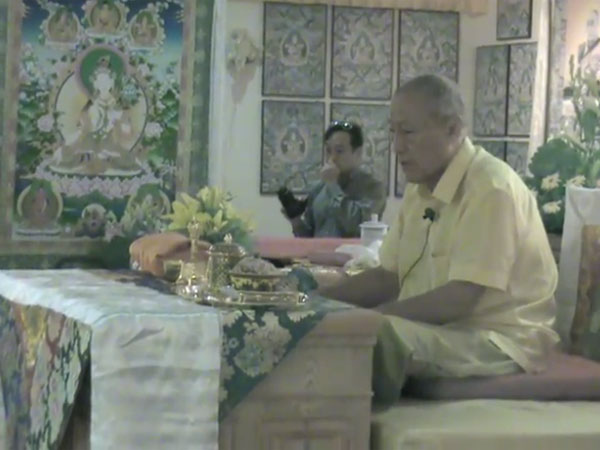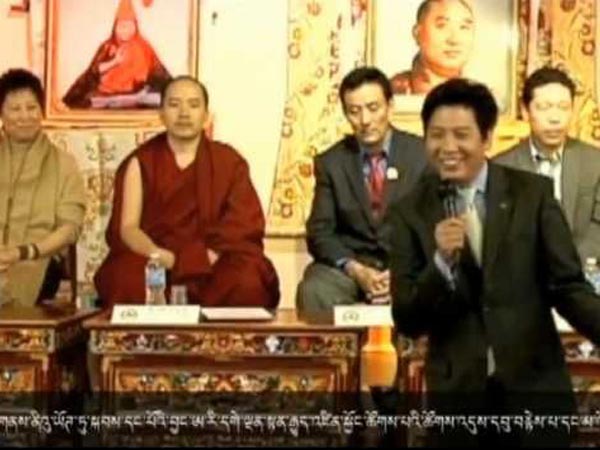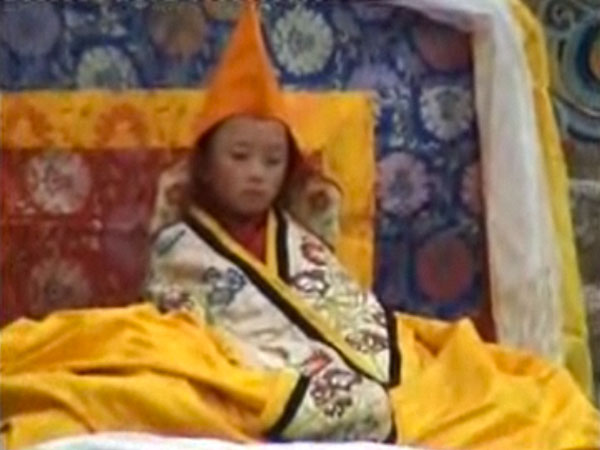DHARMA READINGS
| A TEACHING ON NYINGMA PROTECTOR SHENPA - OFFERINGS TO THE DHARMAPALAS | | Print | |
Page 2 of 3
The Dam Chen Chi Tor is so complete that once you have finished it, you have fulfilled the samaya to all the lineages. All Protectors for all practices come from there. Once you have done this, you can go to the other Protector prayers to pay special respect to individual protectors. Whenever you pour a liquid as an offering to a Protector, you must wear a scarf over your mouth so you don't breathe into the Protectors. The thing about the Dharmapalas is that they are very disciplined wisdom Buddhas. They won't accept any of your faults at all. They will discipline you. If, for example, you breathe into what you are pouring, they will slap you back, and in the same way, if your practice is done correctly and well, you will have a positive reaction back, straight away. It is good to offer red wine to the Dharmapalas, but the best offering is whiskey. Whiskey is expensive, but when you make an offering to the Dharmapalas, and to the wisdom Buddhas, you don't want to be cheap, you should want to offer something good. If you cannot afford whiskey, drop down to wine, and if you cannot afford wine, then offer tea. If you cannot afford tea, what can I say? Along with the liquid that you offer in the Dharmapala cup, you should also offer beef heart. The Dharmapala offering is a symbol of activating the heart core. The chanting and beating of the drum that we do in the Dharmapala practice vibrates the Buddha's heart. From that heart vibration, our heart vibrates. So they vibrate together, which produces the energy that produces the different phenomena. Within the beef heart, all essences are together. If you can' t afford heart , offer a small piece of meat. If you can't afford heart or meat, then offer a biscuit, or a little rice. Basically, the offering should be whiskey, heart, the five kinds of meat and at last one grain of rice. If you are doing a long practice, cut many pieces of meat, and continue to add heart and whiskey as if to say, "Please have, please have." Now it is not just whiskey and meat, but it is nectar we are offering. This offering is a symbol of our heart being opened to the Dharmapala and saying, "Have this." If you have an enemy, the offering symbolizes their heart, as if you were saying, "Please subjugate my enemy." When you say "subjugate" you don't mean kill. Subjugate means you want them to see the wisdom of not harming you. It is a means to bring wisdom to that person. Many times, if someone seeks to harm you, and you are doing Dharmapala ractice, that person will suddenly change their mind and decide not to hurt you. Why? Because the Dharmapala changes their mind about the benefits of harming you. Normally, when we make our offering, the power of the five meats and the five nectars increases the offering in an infinite way, like space, but since we don't have the meditative power to increase it the way it should be increased, if we add a little dudtsi or amrita inside the bottle of whiskey, because the dudtsi has been blessed by the power of meditation, the whiskey will have the strength of meditation. The amrita has the power to make your Dharmapala practice successful. You must have either the power of the practice of relying on your yidam, your meditation, or the substance. The dudtsi contains all three powers, and alone can fulfill all three requirements. It is really powerful. I do that, by the way. You can feel the difference when you add dudtsi to the whiskey. The vibration in the room changes straight away. The Protectors come. In the Nyingma lineage, the key to making dudtsi is knowing how to prepare the nectars. Dudtsi contains five gems, five meats, five nectars, and the relics of all the Buddhas and tertons. It also contains the combination of all the earth that Rinpoche has collected from different areas. When we make dudtsi, we combine relic upon relic, and concentrate it with the 21-day practice of day and night. The practice goes on for 21 days and nights, without interruption. It is an awesome, overwhelming process. The mantra must continue 24 hours a day. Herbs are mixed with the dudtsi, and all of these ingredients, these king medicines, are mixed together. Then the mixture is sealed all around. Bell and dorje are placed in different quarters to symbolize the blessing. The medicine that is prepared must be kept in a mandala, so a whole mandala must be prepared. It must be constantly attended to, with offering lamps and light. And with the practice of Dorje Sempa, Vajrsattva, Phurba or Avalokitesvara, the Lama empowers the medicine with his mind, again and again. It is an extremely complex process to prepare dudtsi. Throughout the practice Tsog is offered. When His Holiness Dudjom Rinpoche prepared it, in the end, as a symbolic thing, people would see rainbows coming out of the dudtsi. Rainbows would cross each other in the air in the room where he worked, and other things like that. Even with an ordinary Lama, due to the strength of the blessings, the skull cup will boil over and radiate light on the ceiling. There are always miraculous signs when dudtsi is being prepared. Always. If you are sick, or have samaya contamination or anything like that, if you eat a little dudtsi it will purify your channels. Dudtsi is really to purify channels. If you add a little to the whiskey, it will make up for whatever you lack in reliance on yidam, meditation, or the power of the substance. When you practice alone, place the Protector offering on your table, not the altar, so you can keep feeding it . Make the offering very carefully, and place a bumpa or water bowl here with a little saffron in it, and keep purifying the Protector offering with the water as well. Also, you can turn the incense around the offering. You must be very diligent, very conscientious of what you are doing. It is very bad if any dirt gets into the offering. The offering receptacle must be washed thoroughly, and make sure your hands are washed too. If you sit down and touch the floor after washing your hands, you might think your hands are washed, but they aren't. Be careful. The best way of disposing of a Protector offering is in the river or ocean. It is also good to keep it in a high place where birds can eat it, like on a post, or in a tree, or put it on clean ground, blocked by a fence or stone, away from where you walk. If you are in retreat, you can collect it in a plastic garbage bag. Don't give the remains to domesticated dogs, cats, or other animals that comprise your extended family. If they are other people's animals and strays, it's not great but it is okay. It is okay for wild animals to consume the offerings. It is good to make the offering every day, especially toward the evening. Q. I don't believe in the Dharmapalas. Everything else about Dharma makes sense, but Dharmapalas don't make sense to me. A. Everybody has a problem with the Dharmapalas. They ask, "Who are they? I don't believe in them." And, my dear, I must say two things to you: First, just because you don't visually see or understand something doesn't mean it doesn't exist. Remember this one. Second, what you don't see is your limitation, not an expansion of your awareness. The reason it is so hard to relate to the teaching of the Dharmapalas is because this teaching is so very, very sophisticated. When you go through all the elaboration of the practice, through all the blood, guts, pus and everything spilling out, and you look at the various vapors that rise up, then you begin to understand. Understanding the Dharmapala is really understanding how your blood and your heart beat relate to your practice. We say your heart is the drum of the Dharmapala. The pumping of the blood is the offering to the protectors, and the beating of the heart is their drum. You must be brought up in the context of being with them, or having seen them or the local protectors. If you can't see the local protectors, how can you hope to see the Dharmapalas? If you can't see your ancestors who have died on this land, how can you hope to see a local protector, let alone a Dharmapala? The level of energy is very high, very subtle. Once your energy is very subtle, then you want to name the subtleness of the Protectors. This is what you want to come to. For example, once, in His Holiness' temple, a man named Pedma Longdu used to beat the Dharmapala drum every evening and make offerings. He had made a commitment to His Holiness to perform this offering ritual, and it was his routine. One night he got drunk and didn't make the offering. He went to sleep. In the middle of the night my mother woke up, maybe around 2:00 a.m., when the Dharmapala drum began beating on its own. She woke up my father and asked him, "Did you ask for a special extension of the practice? What is going on?" Rinpoche just got up and smiled, and said, "It doesn't matter. No, it doesn't matter." The drum beat the whole night, and all the people surrounding the temple could not sleep. The Dharmapala had become very violent, hitting the drum, because the offering had not been put there. The next morning Rinpoche called Pema Longdu, who is now the head Lama of the Buddha Monastery in Kaleekoh, and asked him, "Why didn't you do the Dharmapala practice last night?" The Lama became arrogant and said, "If I miss one day's practice, are they going to get so hungry?" The next day Pema Longdu was hit by a fever, becoming violently ill and almost losing his life. This was because he talked about the Protectors as if they were hungry for an offering, and were so attached to that offering that they couldn't go even one day without it. Right after he said that, his blood started warming up. He couldn't sleep all night, and his heart kept on beating, beating, beating. The next morning, he started vomiting blood. So Rinpoche told him to go straight away into the temple and make prostrations to the Protectors, or they would take his life. The Protectors can take your life force. It really is in their hands. Why? The life force we are talking about in the Chi Med Tsog Thig is the Protector. There is nothing other than that. It wasn't that the Dharmapalas missed the offering. They just showed him that he had lost his discipline in the training of his mind. That is why the Dharmapala showed its hand. It can be a very costly affair.
|
OTHER DHARMA READINGS
- A GUIDE TO SPIRITUAL PRACTICE
- DHARMA DEMYSTIFIED: NAGARJUNA, THE FOUNDER OF THE MAHAYANA TRADITION
- DORJE SHUGDEN ON BLACK HORSE
- WHY MANJUSHRI MATTERS
- DHARMA DEMYSTIFIED: THE ENTHRONEMENT OF DORJE SHUGDEN









